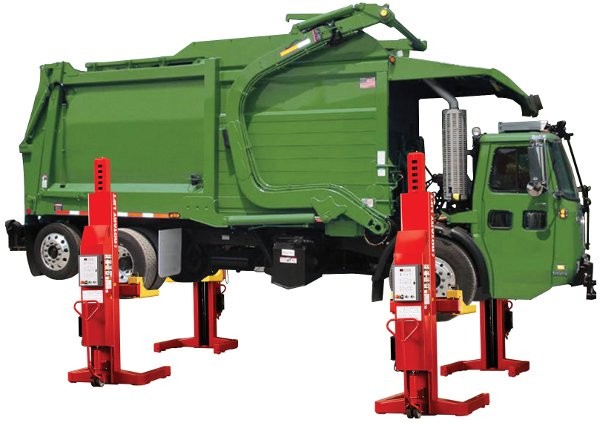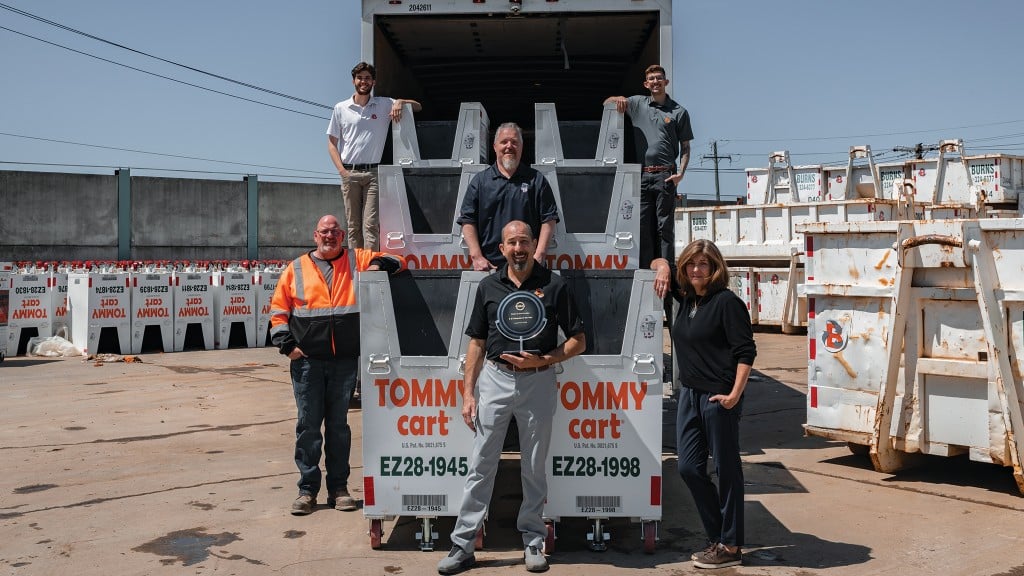The advantages of using heavy-duty vehicle lifts in refuse and recycling maintenance

Refuse and recycling vehicles are some of the hardest-working trucks on the street. They are punished daily with endless stops and starts, hauling heavy loads and bouncing over rough terrain. Keeping them up and running is a full-time job that is crucial to maintaining profitability as well as satisfied customers.
Most refuse and recycling haulers, including municipalities, private haulers and national accounts, perform their own periodic maintenance in-house. Most also handle their own routine repairs, but will send the equipment out for major work, like engine overhauls. For years, work on these trucks was conducted by technicians lying on their backs on creepers or standing in pits under the vehicles. In fact, this is still standard practice throughout much of the industry. Gradually, the use of vehicle lifts has increased in refuse / recycle collection vehicle maintenance garages, as haulers recognize the advantages lifts provide in improving vehicle maintenance speed and accuracy.
Why use vehicle lifts?
There are many advantages to using vehicle lifts instead of relying on floor jacks, jack stands, creepers and pits. For a majority of vehicle maintenance and repair tasks vehicle lifts improve productivity, profitability (or cost savings, for public entities), ergonomics and safety. They also lower worker’s compensation costs and will improve employee recruitment and retention.
Refuse/recycling haulers install vehicle lifts primarily to enable their technicians to perform more thorough preventive maintenance inspections faster and, by doing so, to reduce vehicle downtime. Labour accounts for a considerable portion of haulers’ annual vehicle maintenance expenses. On average, vehicle lifts improve technician productivity and reduce labour costs by at least 25 percent.
Two of the biggest factors affecting technician productivity are access and clearance. Technicians need room to work and access to all vehicle components. This is especially important on refuse collection vehicles, which have far more hydraulic components than standard vehicles. A lift enables the technician to raise and lower a truck into just the right position to be able to check and access every hydraulic hose and other component comfortably, without crawling around on the floor.
Visibility and lighting are also improved. Lifts can also make it easier to perform services that require the wheels to be free or the suspension to be unloaded, such as lubrication, brake, wheel, transmission and suspension work.
With respect to safety, vehicle lifts are designed to safely raise vehicles to a comfortable working height and keep them there. The technician can then easily use tools and equipment to safely remove and replace heavy components without manual lifting. Many lifts can be equipped with lighting to provide a well-lit work area under the vehicle.
Additionally, ergonomic working heights and conveniently located tools and controls can result in less strain on technicians’ bodies, as well as fewer injuries and accidents. This results in healthier employees and fewer lost work hours. Over time, many facilities also see their worker’s compensation premiums reduced.
When it comes to employee recruitment and retention, it isn’t getting any easier to find and retain qualified diesel mechanics. The best technicians these days can have their pick of jobs. And frankly, working on refuse collection vehicles isn’t high on many people’s lists of desirable jobs. In the competition for talented employees, better working conditions can be a significant draw. Given the choice, most technicians prefer to work standing up, with the vehicle raised to a comfortable position, rather than on their backs. Vehicle lifts, especially those that are easy to use and feature the latest technology, can help to attract and retain top-notch technicians. The productivity boost lifts provide may also reduce the number of technicians needed.
Types of heavy-duty vehicle lifts
The three most popular styles of vehicle lifts for servicing refuse and recycling equipment are: mobile column, parallelogram and inground lifts.
Mobile column lifts
Mobile column lifts (shown top) are the fastest-growing category of above-ground lifts. They consist of four or six portable columns linked by a common control system. The columns are individually wheeled to the vehicle, and then connected together via communication cables or wirelessly for synchronized lifting. Mobile columns may be battery-operated or run on AC power, and engage at the vehicle’s wheels.
On some models, wheel forks adjust to different wheel sizes. Others use a fixed fork design for faster loading (best for standardized fleets). Some manufacturers offer optional runway systems to provide the benefits of drive-on lifts. Lifting capacity ranges from 60,000 pounds to more than 120,000 pounds.
Mobile column lifts are portable and extremely flexible. They can be moved between bays, outdoors, or even away from the shop, and can turn empty space into a service area without installation costs. Once the lift raises one vehicle, the truck can be held in place with jack stands, and then the lift can be moved to raise another vehicle. As a result, the fleet may be able to buy fewer lifts. Mobile column lifts also have the lowest upfront costs, including no installation costs. However, moving and repositioning columns for every vehicle can be time-consuming. Mobile column lifts are not suitable for wheel work without accessory jack stands and tire dollies, and they can’t be used for alignments.
Parallelogram lifts
As their name implies, parallelogram lifts rise using a parallelogram motion. This makes them a good choice for collection vehicles, which tend to have off-set axle weights that can be challenging for other lift styles. This is one of the fastest lift styles to use because no set-up is required. The vehicle is simply driven onto runways which are then raised. One to two minutes later, the vehicle is at a comfortable working height. The vehicle is supported on its wheels, although the lift can be fitted with rolling jacks to engage the vehicle at its axles and make it possible to lift the front, rear or all wheels off the runways for brake, tire and suspension work.
Parallelogram lifts are well-suited for most periodic maintenance and repair tasks and can be used for alignments. They are also the best lift style for wash bays. Lifting capacity is 30,000 pounds to 130,000 pounds. Parallelogram lifts provide all-around vehicle access and lights in the platforms make it easier to see when working under a vehicle. Some designs have a continuous base or torsion bars that have the potential to trip technicians and reduce productivity. Parallelograms also take up more bay space than other lift styles.
Inground lifts
Inground lifts have been the top choice of truck maintenance operations for more than 85 years. In the refuse and recycling collection field, however, inground lifts are used primarily by municipal garages that handle a range of vehicles. They are rare in independent or national account garages because those companies tend to outsource the more time-intensive jobs where inground lifts provide the most benefit and return on investment. Inground lifts provide the best access to the various maintenance items on a vehicle and do so in the most ergonomic, space-efficient way.
The original heavy-duty inground lift is hydraulic, with two or three pistons that lift the vehicle. Basic models are installed in deep continuous concrete vaults. Modular inground lifts are contained in six-foot deep steel enclosures that have been designed to prevent leakage, electrolysis or water intrusion into the lift. These lifts are feature-rich, often offering liquid detection systems, programmable wheelbase settings, infinite speed control and onboard training guides.
Rotary Lift introduced the first modular heavy-duty inground lift, the MOD30 modular environmentally friendly inground lift, in 2002.
The newest type of inground lift is the inground scissor lift. This style uses two or three scissor sections to lift vehicles. It is installed in a shallow trench that is less than three feet deep, providing reduced installation costs. Inground lifts engage the vehicle by its axles, so they can be used for virtually any vehicle maintenance and repair task without the need for other accessories. Every other type of heavy-duty lift picks up the truck by its wheels. Inground lifts can be operated by a control box, pendant or above-ground console, while the posts or scissor sections, power units and hydraulics are located in the ground. Lifting capacity is typically up to 90,000 pounds.
Notably, inground lifts have the longest useful life of all lift styles – 25 to 30 years – though their upfront cost is higher than that of surface lifts.



